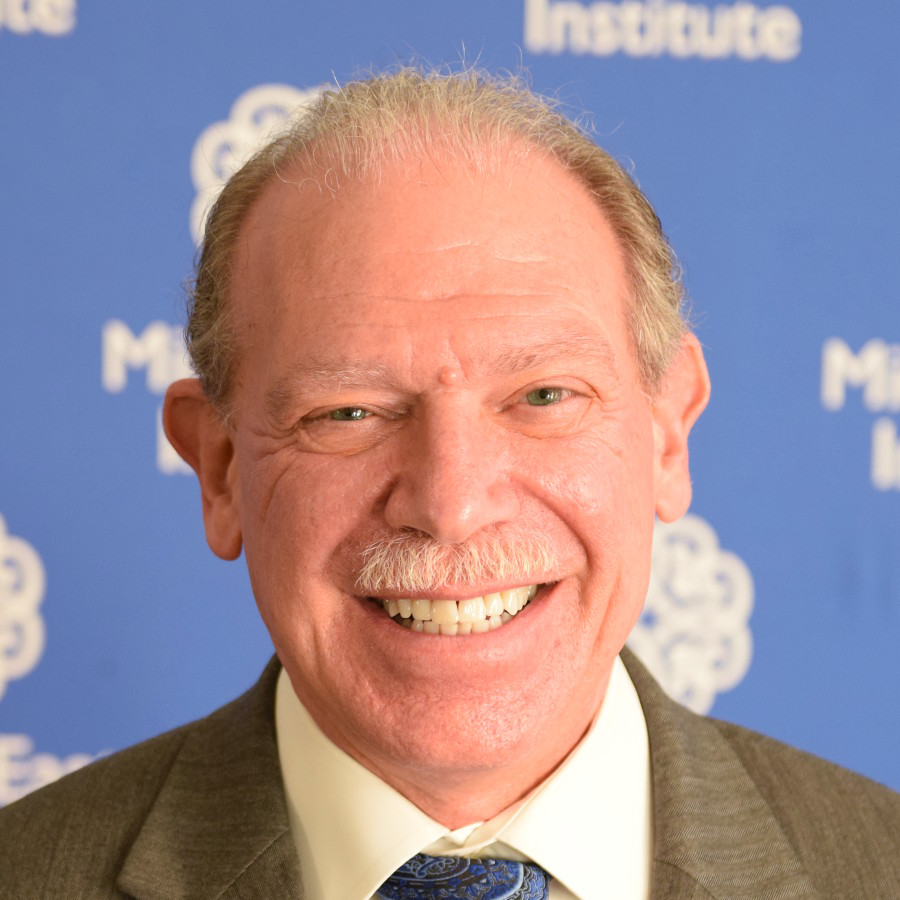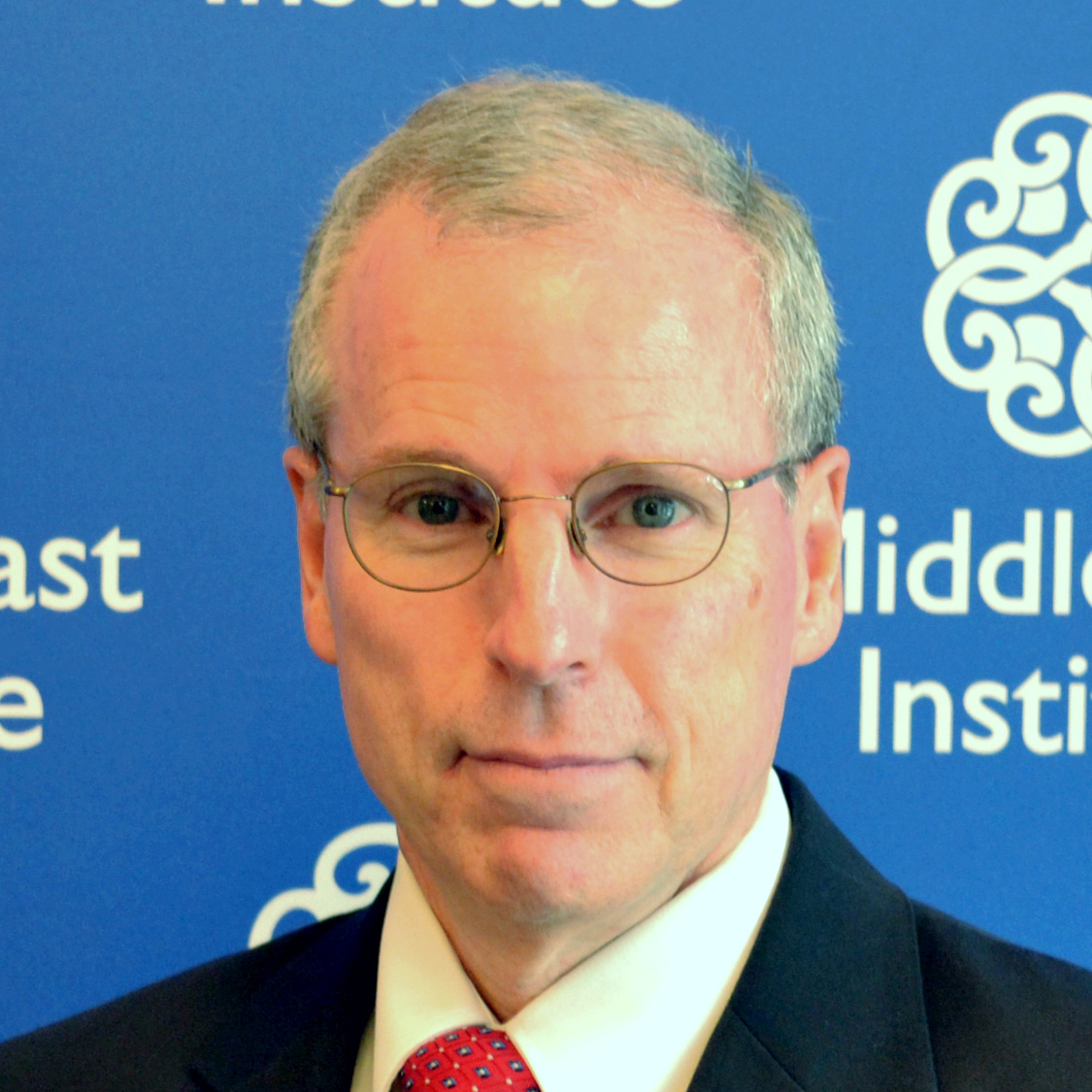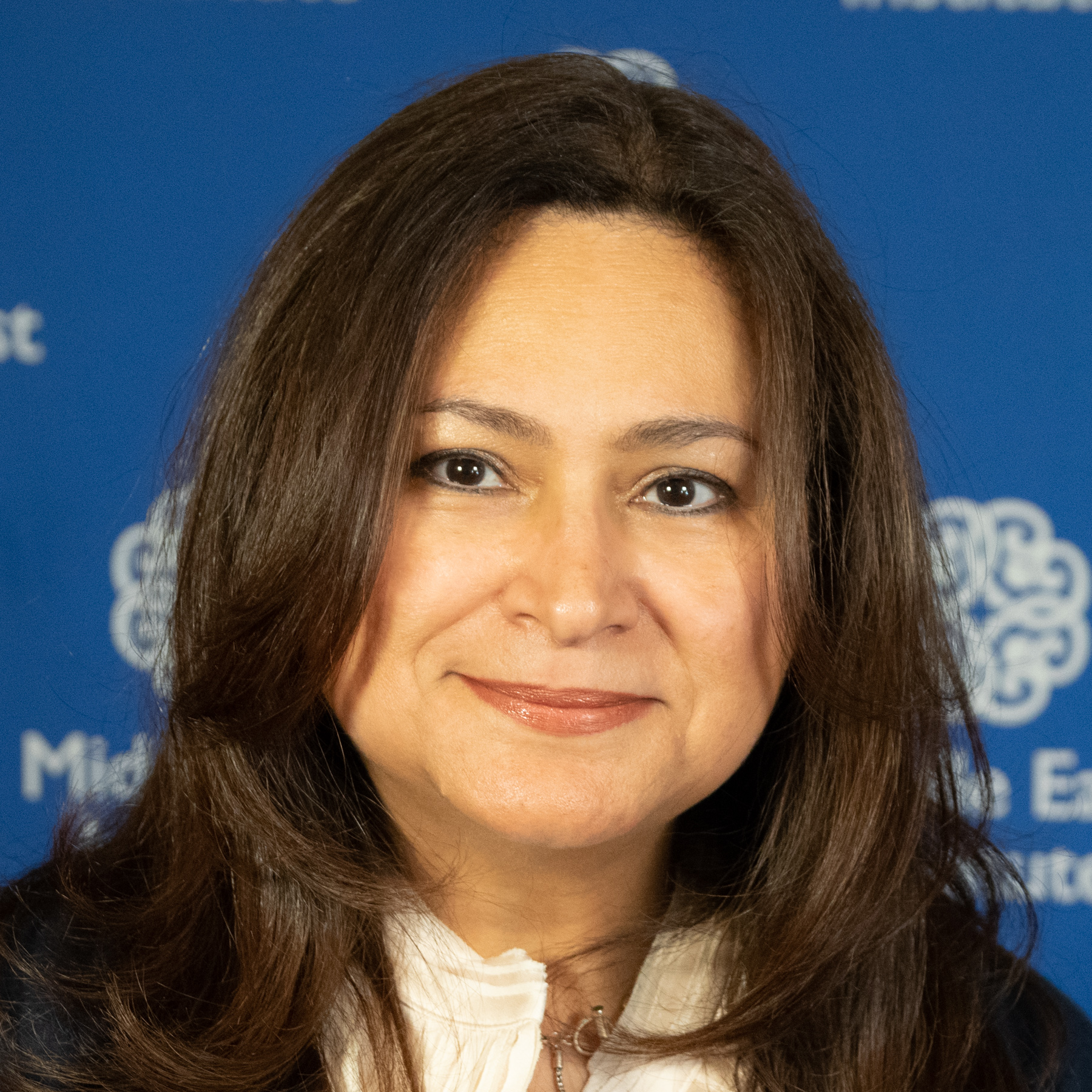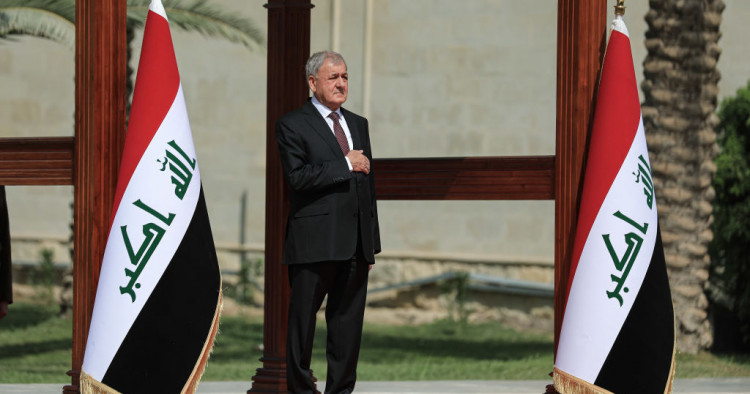Contents:
- Government formation in Iraq: One year, one step
- The realities of Iran’s protest movement, one month on
- US-Saudi relations still buffeted by OPEC+ headwinds
- Biden’s Middle East strategy: Not so far from Trump’s
- COP27: Navigating internal goals and external challenges
- IMF loan for Egypt finally within reach
- Pakistan takes offense at Biden remark
Government formation in Iraq: One year, one step
Shahla Al-Kli
Non-Resident Scholar

-
A year on from the elections of October 2021, Iraq has finally chosen a new president and designated a new prime minister, with the cabinet to be formed over the coming month.
-
Iraq is going through a much-needed structural political transformation, and despite fits and starts, several positive developments, including the establishment of fresh homegrown parties, are emerging amid the ongoing domestic turmoil.
On Monday, Oct. 17, Iraq’s newly elected President Abdul Latif Rashid officially took office, but contrary to the tradition started by former President Fuad Masum, the outgoing President Barham Salih did not participate in the inauguration ceremony. Designated Prime Minister (PM) Mohammed Shia al-Sudani, who was nominated by the Coordination Framework bloc led by former PM Nouri al-Maliki, is expected to finish forming his cabinet by the end of this week; and the national legislature, the Iraqi Council of Representatives, will most likely vote on it by next week.
Concurrently, Iraq was shaken by yet another corruption scandal at the Ministry of Finance, when the angry dismissed acting finance minister, Ihsan Abdul-Jabbar, issued a statement revealing a multi-billion-dollar fraud case. The statement sparked public outrage over such repeat scandals, which have depleted the national budget. The caretaker government opened an investigation into the suspected theft of $2.5 billion from the tax authority.
Iraq’s government formation process, which began right after the country held early elections in October 2021, must now continue against the backdrop of a complicated economic context, exhausted state institutions, and a deeply fragmented political process.
Over the past year, Iraq has gone through severe political turmoil. For the first time in the post-Saddam era, the country faced the possibility of two critically important developments: moving from consociationalism to a majoritarian parliamentarian system as well as the potential outbreak of an intra-Shi’a “civil war.” Despite popular support for a majority government, the leading political parties calling for such a transformation, mainly the Sadrist Movement, failed to achieve the final goal, and Muqtada al-Sadr himself retreated from the political scene for now. His next steps remain unclear, while his constituencies still seek answers as to why their faction lost the opportunity to form a new government despite winning a 73-seat plurality in parliament 12 months ago. Iraq also dodged what, earlier this fall, looked like an imminent intra-Shi’a violent conflict; a confluence of several internal, regional, and international factors saved the country from such an outcome.
Most political analysts agree that, following President Rashid’s inauguration, the Coordination Framework will further consolidate its power in major state institutions and at all bureaucratic levels, probably at Sadr’s expense. However, the politically driven government formation process still has a month to go, and no one can be certain that Sadr or his faction will ultimately be kept at bay.
Concomitantly with these developments, a new coalition was announced in Baghdad on Saturday, Oct. 15. The Forces for Democratic Change (FDC) includes new entities and a number of civil society institutions along with dozens of activists and demonstrators who had taken part in the October 2019 protest movement. The FDC, as explained by its members, represents a new political entity to confront the “traditional political forces and armed factions that dominate the country.” This announcement was the culmination of many months of heated discussions among various mainly youth-led forces representing the October 2019 movement about how to respond to Sadr’s demonstrations. These entities came to realize that they needed to unify and launch a sustainable political platform capable of transforming Iraq’s new liberal youth forces into an electorally competitive force.
Despite the hiccups of the last year, Iraq continues to trudge forward toward a political transformation. The Iraqi political process put in place in 2003 initially relied mainly on once-exiled parties whose power, status, and role were exaggerated through regional clientelism and international necessities. However, the October 2019 protest movement, the subsequent early elections of October 2021, and the political turmoil that has accompanied the government formation process since then, should all be seen as tactical developments in Iraq’s path to strategic transformation. This journey is likely to finally show some tangible results over the next one or two election cycles.
Follow on Twitter: @ShahlaKli
The realities of Iran’s protest movement, one month on
Alex Vatanka
Director of Iran Program and Senior Fellow, Frontier Europe Initiative

-
Khamenei has so far shown no willingness to listen to the voices of protesters. To him, compromise means only one thing: accepting defeat.
-
But Khamenei’s obstinance is confronting a different kind of opposition, a youthful protest movement driven by years of built-up anger. For Iran’s Generation Z, it is Khamenei that is the “dictator,” and it is his fall they demand.
As nationwide protests in Iran enter the second month, a few things have become clear. While Supreme Leader Ali Khamenei once again blamed the West last week, accusing it of being behind the protests, Iranian analysts inside the country are openly refuting him. They point to two basic realities.
First, that Khamenei — who is the only person that can change the regime’s course of action — has so far shown no willingness to listen to the voices of protesters. Compromise means only one thing to Khamenei and that is accepting defeat. He sees no middle ground: The Iranian people will either totally submit to the rule of the Islamist order or the Islamic Republic will collapse.
The second reality, which is a relatively new development, is that Khamenei’s obstinance is confronting a different kind of protest movement, unlike anything the Islamic Republic has experienced since 1979. This youthful protest movement is driven by years of built-up anger that is now bursting into the open. The regime’s own figures show that most of those arrested in the last month are in the 15-25 age group.
This is Iran’s Generation Z, a group that has no memory of the era before the Islamists took over in 1979. More importantly, this is also a group that evidently has little faith in a better future as long as Khamenei rules Iran. For Iran’s Generation Z, it is Khamenei that is the “dictator,” and it is his fall they demand. This generation has no appetite to entertain any ideas of reforming the existing political system.
Unlike their parent’s generation, today’s youth protesters are insisting on an entirely new political order. Articulating what this new order will look like is still a work-in-progress, but no one denies that its minimum demand is the fall of the regime. It remains to be seen if this one demand is enough to consolidate the broad spectrum that is the Iranian opposition.
Back to the analysts in Tehran. Without saying so openly, given self-censorship, they point out that Khamenei is reaping what he sowed. In recent years, the supreme leader has gradually choked off the space for political debate inside Iran. As Abbas Abdi put it, today’s youth in Iran are not even given the pretense of having a choice. Khamenei’s most tone-deaf moves have included installing Ebrahim Raisi as president in 2021 in sham elections and forcing the country to deal with more painful isolation and sanctions by prioritizing his beloved militant Islamist ideology over the national interest and Iranians’ material needs. As Abdi and many other Iran-based analysts point out, Khamenei has left no choice for Iran’s youth. More terrifyingly, he remains stubborn in his ways and believes that he can suppress his way out of the current protests.
In short, three key factors are driving Iran’s current protests. First, Iranian society is fuming with a ruling elite that is nearly entirely detached from the needs and aspirations of ordinary Iranians. Second, the opposition has never been this radical in its demands. It is youthful, determined to bring about major political change, and is already carving out its own path even without having a singular leader or comprehensive agenda. And third, Khamenei has no Plan B, which would suggest the protest movement is here to stay and a new part of political life in Iran until one side prevails.
Follow on Twitter: @AlexVatanka
US-Saudi relations still buffeted by OPEC+ headwinds
Gerald M. Feierstein
Distinguished Sr. Fellow on U.S. Diplomacy; Director, Arabian Peninsula Affairs

-
Amid the fallout of the OPEC+ production cut decision, the Saudis have attempted to neutralize assertions that they have adopted a pro-Russian stance by reiterating that they respect Ukraine’s territorial integrity and were engaging with counterparts in Kyiv.
-
Perhaps recognizing that they were in danger of losing control over management of the bilateral relationship with Saudi Arabia, senior Biden officials have gone to some lengths to reiterate that the two countries continue to share regional and global economic, political, and security objectives that serve critical U.S. interests.
Perhaps surprised by the vehemence of anger in the United States over the OPEC+ decision to cut oil production by 2 million barrels a day, the Saudi leadership took steps over the past several days in an effort to calm the waters. Senior Saudi spokespeople, including newly promoted Defense Minister Khalid bin Salman, continued to defend Riyadh’s decision as based strictly on economic considerations while denying any political agenda.
Meanwhile, the Saudis have attempted to neutralize assertions that they have adopted a pro-Russian stance by reiterating that they respect the United Nations Charter’s commitment to the sovereignty and territorial integrity of member states and were engaging with Ukrainian counterparts. The Saudis announced that they would provide Ukraine with $400 million in humanitarian relief. Crown Prince Mohammed bin Salman, who was recently named prime minister, spoke to Ukrainian President Volodymyr Zelenskyy in a conversation that touched on Saudi mediation on prisoner exchanges, Ukrainian energy requirements, and post-conflict investment possibilities.
It’s not clear that this will be sufficient to assuage Washington. President Joe Biden’s initial angry reaction to the OPEC+ decision and his announced plan to re-evaluate the U.S.-Saudi bilateral relationship has opened the door to expressions of deep-seated, bipartisan antipathy toward Saudi Arabia among Washington’s political elite and activists. In particular, the White House’s response has provoked new calls for ending the U.S.-Saudi security relationship and arms sales along with other potential punitive measures.
Perhaps recognizing that they were in danger of losing control over management of the bilateral relationship, senior administration officials have gone to some lengths to reiterate that, regardless of the frustration over OPEC+, the United States and Saudi Arabia continue to share regional and global economic, political, and security objectives that serve critical U.S. interests. But the president is in danger of becoming the sorcerer’s apprentice, having initiated a debate that he may be able to control only with difficulty. Cognizant of the broader national interest and the limited menu of options, the administration is likely to confine its response to relatively modest measures. In this worst of all possible worlds scenario, the administration is at risk of inflicting more damage to the bilateral relationship while once again opening itself to criticism from the anti-Saudi crowd that their handling of the Saudi file is weak and feckless.
Biden’s Middle East strategy: Not so far from Trump’s
Robert S. Ford
Senior Fellow

-
When it comes to the Middle East, there are many similarities between the Biden national security strategy and the one the Trump administration issued in 2017.
-
Some analysts wonder how the Biden administration will reconcile its goal of an international order that allows all peoples to enjoy “their basic, universal rights and freedoms” with its collaboration with autocracies in the region.
The Biden administration’s national security strategy document released last week, like its predecessors, defines national interests and objectives, but doesn’t offer many detailed policies and initiatives to secure them. There are many similarities in the sections pertaining to the Middle East between the Biden national security strategy and the one the Trump administration issued in 2017. The Trump administration devoted more space to Iranian threats, but the Biden administration highlights Iran’s “destabilizing activities” and warns that it will respond when Iran “attacks our people and our interests.” Both administrations pledged to help regional partners develop the capability to deter and defend against Iranian threats. They both also accented the U.S. would promote economic/political/military cooperation to foster regional stability; the Abraham Accords and the two administrations’ work to secure an Israeli-Lebanese maritime border agreement exemplify this approach. In addition, the Biden administration document, like the Trump strategy, aims at building a regional air defense structure and adds the goal of establishing a joint maritime defense structure as well. Both administrations also highlighted they would build regional partners’ capabilities to stop terror attacks while pledging Washington would strive to help resolve underlying political and economic grievances. For example, the two administrations’ strategies frame the U.S. objective in the Syrian war in terms of working with partners to stop the export of terrorism and managing refugee outflows.
There are some notable differences between the two documents as well. The Biden national security strategy restored the formal American backing of a two-state solution to the Israel-Palestine conflict. It also explicitly mentioned its goal of helping Israel remain both Jewish and democratic, language not found in the Trump administration’s strategy. In addition, the Biden administration briefly mentions that it will try to build “resilience” among states in the region as they grapple with climate change.
Some analysts wonder how the Biden administration will reconcile its goal of an international order that allows all peoples to enjoy “their basic, universal rights and freedoms” with its collaboration with autocracies in the region. The strategy document itself stresses that the United States does not believe governments and societies everywhere must be democratic for America to be secure. Moreover, National Security Advisor Jake Sullivan, in an Oct. 12 speech, observed that the U.S. would work with non-democracies to defend and sustain the rules-based international order and address shared challenges. The strategy document differentiated between such non-democratic states and “revisionist” states such as China and Russia that (1) “wage or prepare for wars of aggression,” (2) actively undermine democratic processes of other countries, and (3) leverage supply chains to coerce and repress. In the weeks ahead states in the region from Algeria to Saudi Arabia will wonder how exactly the Biden administration will define what it truly considers to be “revisionist.”
Follow on Twitter: @fordrs58
COP27: Navigating internal goals and external challenges
Mohammed Mahmoud
Senior Fellow and Director of the Climate and Water Program

-
For COP27, Egypt remains committed to elevating and delivering on topics of importance to climate-vulnerable nations such as climate financing, adaptation, and loss and damage.
-
Several public opinion issues loom large over the conference, such as accessibility for climate activists, Coca-Cola’s corporate sponsorship, the potential absence of U.K. leadership as prior COP hosts, and ongoing global energy issues that may dampen decarbonization efforts.
With the kick-off to the 2022 United Nations Climate Change Conference (27th Conference of the Parties, COP27) in Sharm el-Sheikh less than a month away, both the anticipation for and scrutiny of this year’s meeting continue to grow. Egypt’s conference representatives have been busy with multiple public engagements and events that reinforce their country’s commitments to a number of desired outcomes for COP27 — expanded climate financing, a bigger focus on adaptation, and elevated discussions on loss and damage. Since Egypt has pledged that this meeting will be an “African COP” first and foremost, these intended goals have the highest priority for countries across the African continent, which overwhelmingly are more impacted by the effects of climate change than they are contributors to it.
However, there have been some public concerns regarding this year’s COP, particularly as it pertains to inclusivity and representation as well as staying the course with respect to aligning Nationally Determined Contributions (NDCs) to achieve a future in which global temperatures rise by less than 2º Celsius by the end of the century.
Human rights organizations have accused Egypt of pre-emptively silencing environmental groups regarding topics that may be critical of the government’s environmental efforts. Uncertainty over the ability of climate activists to publicly and vocally demonstrate at COP27 also lingers, even though the host has offered assurances such gatherings would not be prohibited. Other climate activists, particularly those from Africa, have expressed disappointment with a lack of accessibility to the meeting, both in terms of limited funding to support their travel to the event and the availability of accreditation badges to attend its planned sessions.
In addition, Coca-Cola’s recently announced sponsorship of COP27 has been criticized as greenwashing — especially in light of the corporation’s contribution toward plastic waste and pollution and the carbon footprint associated with producing those plastics. Another interesting revelation is the potential absence of the United Kingdom’s top leadership, Prime Minister Liz Truss and King Charles III, next month. This would be unusual as it is common for the previous COP host to show solidarity with the current host by attending the meeting, and nothing shows that commitment more than having the leaderships from both countries present at the proceedings.
Finally, when it comes to energy and decarbonization, the effects of the Russo-Ukrainian war still persist. And when coupled with the recent OPEC+ decision to cut oil production, the global demand for energy may temper the tone in Sharm el-Sheikh on accelerating climate mitigation efforts centered on carbon emission reductions. With adaptation already taking center stage at this year’s COP, progress on mitigation talks may not be as fruitful as was expected when COP26 concluded with the aspirations of the Glasgow Pact.
Egypt is committed to delivering a successful COP that addresses the needs of those nations that require the most attention and support due to climate change, but it will still need to contend with some bumps along the road to get there.
IMF loan for Egypt finally within reach
Mirette F. Mabrouk
Senior Fellow and Founding Director of the Egypt program

-
The IMF agreement for Egypt stipulates reforms across the board: fiscal, monetary, and structural.
-
Among the requirements is for Egypt to increase the competitiveness of its market — code for asking the public sector to step back and let the private sector do its job.
Bridges in Egypt have been built in less time.
After almost eight months of discussion, a staff-level agreement (SLA) between the International Monetary Fund (IMF) and Egypt has finally been agreed, according to Minister of Finance Mohamed al-Maait. The final SLA is expected to be signed in Cairo “soon.”
The discussions were finalized on the sidelines of the World Bank/IMF Autumn Meetings. Egypt, which is still paying off its last $12 billion IMF loan, from 2016, had requested another loan back in March. Despite its economy having held up reasonably well to the battering inflicted by the COVID-19 pandemic in 2020-21, by spring of 2022 it was in no shape to withstand the fallout from the Russian war on Ukraine as well.
This new loan won’t be anywhere near the size of the IMF line of credit from six years ago; it’s much more likely to come in somewhere around $3 billion. However, while a bigger loan would have been desirable, it would have had to be significantly larger to make any sort of a dent in Egypt’s external debt. Rather, the loan is vital because it represents a stamp of approval by the IMF as well as its recognition of the government’s previous consolidation efforts and a confidence in the Egyptian economy, without which the vast majority of foreign investors wouldn’t want to proceed.
The agreement stipulates reforms across the board: fiscal, monetary, and structural.
On the fiscal side, among other requirements, the Egyptian government has to commit to keeping the debt-to-GDP ratio at no more than 80% in the near term. It also is obligated to prolong government debt maturity and diversify its financing sources. Finally, it must work on transparency and financial disclosure, improve budget efficiency, and raise spending on human development — the latter loudly articulated by Egyptian legislators, economists, and those in the medical and educational fields well before the IMF stipulation.
However, the Egyptian government will be able to continue to raise public spending for social protection, including the the Takaful and Karama cash transfer programs and the Haya Karima initiative to develop the countryside. Considering the link between poverty and instability, this would have been an essential component in the Egyptian government’s negotiations.
Egypt has long needed to make vital structural reforms. Among the IMF loan stipulations is that the government increase the competitiveness of the market — code for asking the public sector to step back and let the private sector do its job. While these reforms have been interminably slow to come about, it’s possible that a combination of the IMF pressure and the ravages wrought on the economy by both the fallout from the pandemic and the Russian war will finally provide the necessary impetus for change.
Two other notable items on the list of stipulations are the need for Egypt to curb inflation and increase foreign exchange (FX) rate flexibility. The IMF has been beating the exchange rate drum for a long time. A few days ago, when asked why the negotiations had been taking so long, IMF Chief Kristalina Georgieva noted, “It boils down to exchange rate policy in Egypt,” adding that it needs to be “thoughtfully designed.”
It’s an argument the Egyptians appear to have come around to. Maait had already argued for it months earlier and recently said that “the stable FX rate has had negative impacts on Egypt’s reserves and the economy as a whole, especially in light of the external global economic shocks.” Indeed, it is generally understood that the former governor of the Central Bank of Egypt, Tarek Amer, stepped down because of his opposition to it.
Follow on Twitter: @mmabrouk
Pakistan takes offense at Biden remark
Marvin G. Weinbaum
Director, Afghanistan and Pakistan Studies

-
President Biden’s unguarded remark reenforces widespread anti-American sentiment in Pakistan and plays perfectly into the playbook of former Prime Minister Khan.
-
The row comes at a time when there has been a visible improvement in bilateral relations.
President Joe Biden took many by surprise with his comment, delivered at an informal fundraising event last Saturday, that lumped a nuclear Pakistan together with China and Russia as “one the world’s most dangerous countries,” a designation he linked to Pakistan’s destabilized political scene. Although more likely an off-hand remark rather than a considered pronouncement, the utterance brought sharp repercussions in Pakistan and an immediate White House effort to soften its impact. Press Secretary Karine Jean-Pierre parried the Biden remark with the anodyne-like statement that “the President views a secure and prosperous Pakistan as critical to U.S. interests.”
While Biden had apparently not intended his comment to be a questioning of Pakistan’s command and control over its nuclear weapons, it was certainly taken that way by government circles in Pakistan. Prime Minister Shehbaz Sharif took great offense at the idea that Pakistan was not a responsible nuclear state. U.S. Ambassador to Pakistan Donald Blome, relatively new at his post, was summoned to the Foreign Office for a fuller explanation as well as to underscore the government’s displeasure with the Biden remark.
The row comes at a time when there has been a visible improvement in bilateral relations. Recent weeks have seen well-received visits to Washington by Pakistan’s army chief and foreign minister, as well as the U.S. announcement of the renewal of military assistance to Pakistan. Also, a recent trip to Azad Kashmir reportedly by the U.S. ambassador was greeted in Islamabad as an indication of greater American interest in Pakistan’s dispute with India over Kashmir. Meanwhile, Pakistan is now reportedly providing munitions to Ukraine in a move that suggests the government is distancing itself from the cozy policy toward Moscow pursued by previous Prime Minister Imran Khan.
It is unlikely that this flareup over Biden’s comment will be allowed to seriously affect improving bilateral relations. It does underscore, however, Pakistan’s sensitivity about criticism of the country’s nuclear policies and the defensiveness of its government, which is besieged with a host of economic and humanitarian problems. Currently, Pakistan is also holding its breath to see whether it will be taken off the Financial Action Task Force gray list of countries declared deficient in enforcing anti-terrorist financial controls. More lastingly, the president’s unguarded remark reenforces widespread anti-American sentiment in Pakistan and plays perfectly into the playbook of Khan, who, in trying to unseat the government, continues to push the narrative that the U.S. is no friend of Pakistan.
Follow on Twitter: @mgweinbaum
Photo by Ameer Al-Mohammedawi/picture alliance via Getty Images
The Middle East Institute (MEI) is an independent, non-partisan, non-for-profit, educational organization. It does not engage in advocacy and its scholars’ opinions are their own. MEI welcomes financial donations, but retains sole editorial control over its work and its publications reflect only the authors’ views. For a listing of MEI donors, please click here.













